Stillman Pond
Stillman Pond (October 26, 1803 – September 30, 1878) – a farmer, harnessmaker, and land speculator by trade, and a native of Hubbardston, Worcester, Massachusetts – was a Mormon pioneer and church leader recognized for the great personal sacrifices he made in the Mormon exodus from Nauvoo, Illinois, to the Great Basin's Salt Lake Valley (September 1846 – September 1847), in what would later become Utah Territory.[1]
| Stillman Pond | |
|---|---|
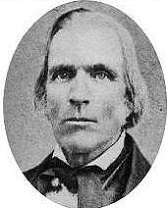 | |
| Second Quorum of Seventy | |
| May 17, 1845 – February 16, 1853 | |
| Called by | Brigham Young |
| End reason | Honorably released because of his calling and setting apart as Senior President of the 35th Quorum of Seventy. |
| Senior President of Thirty-fifth Quorum of Seventy | |
| February 16, 1853 – September 30, 1878 | |
| Called by | Brigham Young |
| End reason | Death. |
| Personal details | |
| Born | October 26, 1803 Hubbardston, Worcester, Massachusetts, United States |
| Died | September 30, 1878 (aged 74) Richmond, Cache, Utah Territory, United States |
Massachusetts: the beginnings of joy and affliction
Stillman Pond was the descendant of hardy colonial New England progenitors of the Puritan persuasion, many of whom served as ministers and selectmen of various townships.[2] The Massachusetts native was born only two years before the birth of the prophet Joseph Smith, Jr., with whom he shared a common ancestry (in separatist minister John Lathrop, 1584–1653) and whose fledgling American religion he would one day embrace.[3]
While Stillman's paternal grandfather, Joseph Pond (b. 1756) was a Revolutionary War soldier, his great-great-grandfather Ezra Pond (b. 1692) was a restless, dissatisfied pastor of a local Franklin, Massachusetts congregation. In the Puritan spirit of Roger Williams and Anne Hutchinson, Ezra refused to comply with the orders of the community elders, and he was forced to leave town, moving with his family to Hubbardston. Stillman's maternal great-great-grandfather was Lt. Paul Moore (b. 1711), an American army commander at the Battle of Bunker Hill.[4]
Perhaps because of the firebrand nature of his religious heritage, a passionate, restless strain of spiritual fervor seemed to course, as it were, through Stillman's veins.[4] It was this spirit that later would move him, in the autumn of 1843, to commit his growing family to making an arduous trek across five states to a burgeoning new city on the Mississippi – Nauvoo, Illinois – where they might join with the relentlessly driven body of Latter-day Saints there assembling.
Stillman himself – a farmer, harnessmaker, and land speculator by trade – was ever thrifty and industrious from the days of his youth, always ensuring that he sold at a profit. Marrying in 1825 one Almyra Whittemore, he removed to Westminster, Worcester, Massachusetts, where he purchased several tracts of land. There he remained until 1832, when he moved to Templeton. Almyra bore him 5 children (four girls and one boy), but at age 33 she died in the yellow fever epidemic that swept through New England in 1833 and was buried at Hubbardston.[5]
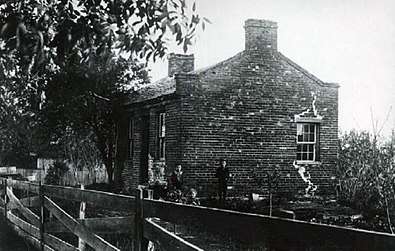
Mormon convert and polygamist
A young widower now with five children, Stillman Pond would ultimately marry five times and produce a multitudinous posterity.[1]
Marrying again for the first time in 1834, to one Maria Louisa Davis, Stillman settled again at Hubbardston, but moved his family in 1837 to New Salem, Massachusetts, purchasing there three tracts of land over the next five years. There, he and his family fostered new friendships, including with the Haskell family (later reuniting with them at Nauvoo).[6] Most significantly, it was at New Salem in 1841 that Stillman and his family welcomed into their home traveling Mormon missionaries and were converted, through their efforts, to the new faith that Smith had founded a decade earlier. The family was baptized on December 28, 1841 under the hand of Elder Elias Harris.[4]
The Mormon message, which afforded hope for his loved ones, both living and dead, filled Stillman's troubled soul with great comfort and peace. Able to sell his land in order to join the Missouri-driven Latter-day Saints at Nauvoo, Illinois, Stillman and his family, having embraced 'the New Covenant,' made their trek in the fall of 1843.
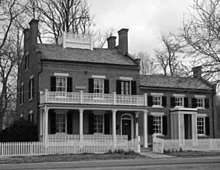
Nauvoo merchant, Elder and Seventy
In the would-be refuge of the 'City Beautiful' Stillman built a two-story red brick home (in the front part of which he established a store) a few blocks southwest of the Nauvoo Temple on Munson Street (block 106) – equidistant at points east and north from the banks of the mighty Mississippi, which forms the city's southern and western borders.[6]
Their new neighbor, as Stillman soon discovered, was a latter-day Apostle of the Lord, for not only did the edifice lay but 'a few rods' west of the homes of friends and fellow converts Winslow Farr and his son Lorin,[7] but also just east of the historic red-brick residence of Mormon Apostle Heber C. Kimball – confidante and councilor to the Mormon Prophet of the Restoration, Joseph Smith, Jr. Another apostle, moreover, resided on the same block – Wilford Woodruff – whose red-brick home stood just north of the Farr homes on Durphy Street.
.jpg)
The Pond family home & store (1843–1846) was thus situated west of the intersection at Durphy and Munson Streets (its site excavated in 1970 by Nauvoo Restoration Inc.) – on the same 4-acre 'lower city' lot where, in their restored incarnations, the historic Kimball, Woodruff, and Farr homes can be seen today (the Winslow Farr home is at the intersection's northwest corner).
Ordained an Elder of the church in July 1844 (only weeks after the Prophet Joseph's martyrdom), Stillman received his patriarchal blessing under the hands of the Prophet's uncle, John Smith, on January 1, 1845, and that same year (17 May) became a member of the church's 2nd Quorum of Seventy, receiving also with his wife (and his first wife by proxy) the ordinance of the holy Endowment in the still unfinished Nauvoo Temple on December 30.[4]
Stillman, on February 12, 1846, wrote: 'I am perfectly satisfied with the authorities of the Church and consider it my indispensable duty to give heed to all things.'[8] Not long after, his young married housekeeper Irene Haskell Pomeroy[9] – who assisted Sister Pond in her ongoing recuperation following the tragic January 1845 death of infant son Charles Stillman Pond – observed firsthand Stillman's commitment to that personal mandate: 'Team after team is going over the river every day for the west ... Brother Pond has gone to help some over the river ...'[10]

Faithful flight: Winter Quarters tragedy & Mormon trek West
The Pond family – after surviving the Battle of Nauvoo against their intolerant oppressors, as well as the vile persecutions which followed – took their flight from the city at the point of bayonet in the fall of 1846.[11] They were among the last of the persecuted Saints to leave Illinois. Stillman's family (including Maria, who was pregnant with twins), together with the other Mormon exiles, were left to stumble on to Winter Quarters across the frozen flats of Iowa.[12][13]
Throughout that bitterly cold, disease-infested season (as they lived in tents on the Nebraska bank of the Missouri River) – with hardships to come thereafter, in the John Taylor-led 1847 trek across the Great Plains to Utah's Salt Lake basin – Stillman lost to sickness and to death his beloved wife and little-kingdom of 8 children.[14][15]
For after the death of infant-son Charles in Nauvoo, the Ponds now lose, on their forced September exodus to Winter Quarters, not only 9-year-old son Lowell Ansen Pond, but also, in mounting grief, malaria-wracked Maria's newborn twin sons. In what was both christening and burial, they honored the infants with the names of the martyred Smith brothers, Joseph and Hyrum. All three sons were buried along the trail in shallow graves in the frozen ground.[5]
But for Stillman and Maria Pond, suddenly bereft as they were of four small children, an already-devastating sacrifice was far from finished. For then is recorded, in the journals of pioneers Horace K. Whitney and Helen Mar Kimball Whitney,[16][17] the deaths of four additional Pond children after the destitute family's October 16 arrival at the Nebraska encampment – with three of the Ponds' daughters all dying within one five-day period alone:
'On Wednesday, the 2nd of December 1846, Laura Jane Pond, age 14 years, ... died of chills and fever.' Two days later on 'Friday, the 4th of December 1846, Harriet M. Pond, age 11 years, ... died with chills.' Three days later, 'Monday, the 7th of December, 1846, Abigail A. Pond, age 18 years [and a plural bride of Presiding Bishop Newell K. Whitney] ... died with chills.' Just five weeks later, 'Friday, the 15th of January, 1847, Lyman Pond, age 6 years, ... died with chills and fever.'[18]
Ursula Billings Hastings Haskell, fellow 'Camp of Israel'[19] saint, and friend of the Pond family from their New Salem days together (and whose housekeeper-daughter Irene had boarded in an apartment in Stillman's Nauvoo home),[20] later wrote in a letter: 'I suppose you have heard of the deaths in Brother Ponds family. The children are all dead but Elizabeth and Loenza.' Sister Haskell then explained in her letter that the family became ill before arriving at Winter Quarters when Brother Pond paused to earn some money for his family's survival in an unhealthy location, 'a very sickly town' out of the way. 'Lowell died before they arrived, the rest lived to get here and then dropped away one after another. Sister Pond has not recovered and I fear she never will.'[21]
All of the marked Pond siblings perished over an 8-month period in the unforgiving elements of their harsh environs, including, finally, on May 17, 1847, a grief-stricken Maria herself (who, though weakened by malaria, was ultimately overcome by 'consumption' or tuberculosis).[22] And Stillman, once more a widower, unspeakably grieved for each and every one. On too-frequent occasion, moreover, he found himself straddling the threshold of death.[23] But 'the fire of the New Covenant' burned brightly in Stillman's soul, and it was that which, after leaving the Missouri River encampment on June 17, gave him the strength to press on to the mountains of the West, where he knew he would find the Zion that God had prepared for His saints.
Abigail Thorn and a Prophet's mantle
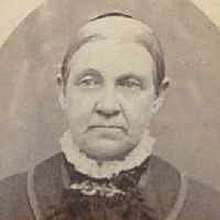
Stillman's third wife, Abigail Thorn,[24] whom he married at the Endowment House at Salt Lake City in 1849 and by whom he would have 8 additional children, was the abandoned plural spouse of Major Samuel Russell who had, only a year earlier, deserted Abigail and their own newborn infant in preference for the gold fields of California. Stillman had been a member of the same (combined Smoot-Wallace-Russell) 'Camp of Israel' company as the Russells in the trek to Utah (arriving September 25, 1847), and he had since established himself in farming to the west of the city, where he'd witnessed the saving of his locust-infested crops in 1848 by the miraculous arrival of seagulls.[5]
For her part, Abigail – born into a respected family[25] at Lair, Cayuga, New York, on April 2, 1821 – had experienced a powerful conversion to the Mormon faith as a young woman. The same glorious spirit which had so moved her then, had again urged her to join with the Saints at Nauvoo. There, at the age of 22, she received in the spring of 1843 her patriarchal blessing under the hands of Hyrum Smith, the Prophet's brother, just fifteen months before his martyrdom at Carthage. Hyrum blessed her with the gift of dreams and visions by the Holy Ghost (she would also enjoy in her life the gift of tongues and a keen discernment of spirits). Hers was the special privilege of witnessing at Nauvoo on August 8, 1844, as scores of accounts that were recorded at the time attest,[26] the transfiguration of Brigham Young, when the mantle and unmistakable voice of the Prophet Joseph Smith fell upon him as a special sign to the Saints of his high calling and acceptance of the Lord to lead His people.[4]
Pioneering at Spanish Fork and Cache Valley
Like Zebedee Coltrin and other Saints who preceded them,[27] Stillman and Abigail removed south from Salt Lake to Spanish Fork in 1857. But less than three years later, in 1860, they turned back again, this time to Cache Valley's Richmond in the far north – just months before shots were fired at Fort Sumter in the East the following spring. Their hard-won livelihoods passed quietly during the years of national Civil War. The Ponds considered themselves greatly blessed.[4]
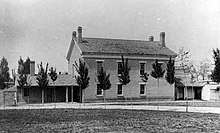
Endowment officiator, Seventy's President and Apostolic mentoree
Stillman had been able to officiate in the Endowment House in Salt Lake City under the supervision of President Heber C. Kimball, but also, at the Council House, to be mentored in mathematics and astronomy in the evenings under the clear, guiding voice of Apostle Orson Pratt.
In 1852 Stillman had once again married, this time to Elizabeth Bessac, by whom he was given another child. But his fourth wife divorced him a few years later and married another man. Yet was Stillman's fidelity and obedience rewarded by church leaders, and on February 16, 1853 he was ordained Senior President of the 35th Quorum of Seventy – a calling and capacity he faithfully fulfilled for the remainder of his days.[5]
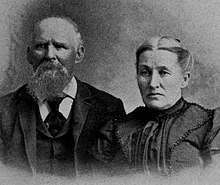
Eldest son, ZCMI investor and St. George Temple laborer
Notwithstanding those hard-life years in Richmond, Stillman received for his comfort (on June 25, 1865) a second patriarchal blessing under the hand of Patriarch Charles W. Hyde – just weeks after the assassination of President Lincoln (Stillman's eldest daughter by Abigail, Mary Anner Pond, only 4 weeks before Lincoln's death, had married John Buxton, an English immigrant who became a successful businessman in Teton Valley, Idaho; they raised 12 children).[28]

Three years after receiving his second patriarchal blessing, Stillman returned to his natal home of Hubbardston, Massachusetts, upon the occasion of his father's passing. There, he secured his 'eldest' son's portion of his father's estate, returning again to Utah to invest his inheritance in the Richmond Co-op, known as the ZCMI – an investment that proved to be a wise and profitable one. In his later years, Stillman would travel south to St. George to assist in hauling quarry-stone for the building of a temple there.[4]
Final years and family legacy
In 1870 Stillman married for a fifth and final time. A widow, Anna Regina Svensson-Jacobsen (alternatively, 'Swenson'), bore him an additional four sons before his death at age 74 (after a two-year lingering illness) on September 30, 1878. Third wife Abigail died 26 years later on March 7, 1904.[4]
By all of these wives Stillman would become grand-patriarch to a sea of descendants scattered throughout the intermountain West (and beyond) bearing such names as Buxton, Bowen, Merrill, Whittle, Kingsbury, Lewis, Egbert, Read, Pope, Telford, Yeats, Van Noy, Rose, and Russell. From a foundation of noble progenitors, Stillman left his multitudinous posterity with a mighty 'fire of faith' legacy – one of sacrifice, endurance, and forging ahead (despite overwhelming heartache and loss) to realize, at last, through unflinching tenacity, persistent labor and love, a useful, abundant, and well-lived life.[5]
References
- Esshom, Frank (1913), "POND, Stillman", Pioneers and Prominent Men of Utah, in One Volume, Illustrated, Salt Lake City: Utah Pioneers Publishing Company, pp. 109, 1107–08
- Helene Holt (1987). EXILED: The Story of John Lathrop, 1584–1653, Appendices A-E, Paramount Books, New York; and Truman G. Madsen (1989), Joseph Smith the Prophet, pp. 107–108, and (2004) Presidents of the Church, Deseret Book, Salt Lake City – Predominantly via matriarchal lines, Stillman Pond was a sixth-generation direct descendant of the Reverend John Lathrop (1584–1653) – the stoic 17th-century separatist minister from England (and a contemporary of Shakespeare) who for his determined faith endured inhumane persecution and imprisonment by Archbishop William Laud of London, but who fled to America to achieve religious freedom for his family and followers. Lathrop fathered a most distinguished and impressive American progeny – that is to say, he stands preeminent among the ancestors of the Prophet Joseph Smith himself (Lathrop is Smith's fifth great-grandfather), Hyrum Smith (and Hyrum's own LDS Prophet-progeny of Joseph F. and Joseph Fielding Smith); several U.S. Presidents, including U.S. Grant, FDR, and the Bushes; LDS Church leaders Wilford Woodruff, Frederick G. Williams, Oliver Cowdery, Orson and Parley P. Pratt, W. W. Phelps, Orson F. Whitney, Zina Huntington Young (Smith), George Albert Smith, Harold B. Lee, Spencer W. Kimball, Ezra Taft Benson, Gordon B. Hinckley, N. Eldon Tanner, M. Russell Ballard, and Marion G. Romney; high-profile citizens, including the Utah Romney and Huntsman families (including Governors George and Mitt Romney and Governor Jon Huntsman, Jr.), Governor Sarah Palin, Stephen R. Covey, Hyrum Smith (Franklin Quest/Franklin Covey founder), and a great swath of other American historical, cultural, and literary figures, such as poet Henry Wadsworth Longfellow, romantic novelist Nathaniel Hawthorne, chief justice Oliver Wendell Holmes, banker J. P. Morgan and investor Henry Sturgis Morgan, educator Benjamin Spock, inventor Eli Whitney, actors Clint Eastwood and John Lithgow, and fiction writer Orson Scott Card. John Lathrop's story is that of a highly principled religious reformer and tireless community and nation builder, whose many descendants have strongly influenced the development of American government, law, medicine, science, industry, culture, and religion.
- Madsen, Truman (1989). Joseph Smith the Prophet. Salt Lake City, Utah: Bookcraft. pp. 107–108.
- Pond, Leon Y. & H. Ray Pond, Stillman Pond, a Biographical Sketch, ed., Sterling Forsyth, Histories, LDS Historical Department, Salt Lake City.
- Pond, Ricky Lynn. ed. SUP Pioneer Stories: Stillman Pond – 1847 Utah Pioneer and his Family The Sons of Utah Pioneers (SUP) online edition.
- Haskell, 'Letters of a Proselyte: The Hascall-Pomeroy Correspondence' (letters of Irene Haskell Pomeroy and her mother Ursula B. Haskell, 1845–1854), Utah Historical Quarterly 25, four quarterly installments (Jan–Oct 1957).
- Haskell, 'Letters of a Proselyte': 'I [Irene] am now at Lorin Farrs nursing his child, a little boy named Enoch. His wife has a broken breast. It is only a few rods from brother Ponds [January 23, 1846],' p. 142. Waterford, Vermont native Lorin Farr (1820–1909) was a bodyguard-scribe to the Prophet Joseph Smith and, later, father-in-law to Apostle and First Presidency member John Henry Smith, and the maternal grandfather of LDS Church President George Albert Smith. After the arrival of the Latter-day Saints in Utah, Farr became the first mayor of Ogden City. Farr's sister Diantha was married to the Prophet's clerk and Council of Fifty member William Clayton, who, as a clerk also to Brigham Young, went West when he did. Diantha was expecting and stayed at Nauvoo until after her baby was born; when word reached William in Iowa that Diantha had born a healthy baby, he penned words to a hymn for the Mormon people called 'Come, Come Ye Saints.'
- Pond, Leon Y. & H. Ray Pond, Stillman Pond. The LDS song 'Follow the Prophet,' written for Mormon Primary children in 1989 by musician-composer and scriptwriter Duane E. Hiatt, was based on Stillman Pond's story of faithful adherence to the counsel of him whom Latter Day Saints regard as God's living mouthpiece on earth.
- Haskell, 'Letters of a Proselyte' (1957), pp. 55, 60–63, 67–69, wherein Irene Haskell Pomeroy (1825–1860) describes the Pond family home and location, the completion of the Nauvoo Temple, Independence Day, mobocracy, and Millennial hope – all reflections made in what she perceived Nauvoo to be – 'a perfect garden [6/2/1845]': 'If you would step into Nauvoo, enter at the lower landing [flatland, or lower flats], pass up Main St, then Munson St, until you come to a one story and half brick house very pleasantly situated between two others of similar description [the Kimball and Farr homes?]. Step into the front entry, open the door on the right (without knocking): there you would see Irene [7/4/1845] ... Elder Farr is married and is one of our nearest neighbors ... We have commenced housekeeping. We have part of Br. Ponds house. It is quite convenient. We have a very pretty room with three windows, front entry and outside door and backdoor, a cupboard, closet and fireplace. lt is quite a pretty house but not all finished. Made of bricks, four windows in front, below, and four half ones above. It is situated on Munson Street in one of the pleasantest parts of the city, not much more than one fourth mile from the river. We can see the boats as they pass [6/2/1845] ... I have been to view the Temple. It is a splendid building. The top stone was laid with Praises and Hosannas the morning before I arrived and that day they rested from their labors. The roof is partly on. It never went on so fast before. Half has been built since Joseph was killed. It was not expected the stones would all be laid until fall. They are now encouraged and think they will be able to have meetings and commence endowment before snow falls. More than three hundred are at work on it and the rest help by paying their tything [sic] &c. The Nauvoo House goes on too ... I delayed writing on account of the trial of the murderers at Carthage. It is thought the murderers are at liberty ... We expect the Temple will have to be completed with a sword in one hand and tool in the other [6/2/1845] ... The Temple progresses finely. The roof is nearly shingled. The framework of the Steeple is nearly as high from the roof up as the body of the Temple. They expect to commence the endowment this fall [July 27, 1845] ... It is Independence Day ... but we think now the independence of the United States is too near gone to raise the flag of liberty [7/4/1845] ... I suppose there were balls, tea parties and the like in the East, but here there were nothing of the kind. The Mormons think the liberty and independence of the United States has been too long trampled upon to be celebrated [7/6/1845] ... Joseph preached just before be died that this city would be headquarters, but there is a time [before the Millennium] when the Saints will enter the secret Chambers [of the Temple] for the Scourges and Judgements to pass through and purify even this city, but when I do not know [July 27, 1845] ... Br Pond and Girls send love. They are building a wall 14 feet high I believe enclosing 7 or 8 acres but does not take in the city buildings. They are building an arsenal also. Within the wall will be all kinds of flowers and trees [6/2/1845].'
- Haskell, 'Letters of a Proselyte' (1957), pp. 55, 62 [6/2/1845], 145 [5/2/1846].
- Faust, James E. (April 1979), "The Refiner's Fire", Ensign, LDS Church
- Flake, Lawrence R. (June 9, 2015), "I Could Not Be Shaken", BYU-Hawaii Speeches, Laie, Oahu, Hawaii: Brigham Young University-Hawaii
- Faust, James E. (February 2006), "Refined in Our Trials", Ensign, LDS Church
- Parry, Jay A. & Donald W. Parry (2003), "Understanding Death", Understanding Death & the Resurrection, Salt Lake City, Utah: Deseret Book, ISBN 978-1-57008-826-1
- Top, Brent L. (July 22, 1997), "It Still Takes Faith: Our Pioneer Ancestry", BYU Speeches, Provo, Utah: Brigham Young University
- The Whitneys were the parents of future Apostle Orson F. Whitney; Helen was also a plural wife of the Prophet Joseph Smith – Bennett, Richard E. (ed.), The Journey West (2018).
- Bennett, Richard E. (ed.) (2018), The Journey West: The Mormon Pioneer Journals of Horace K. Whitney, with Insights by Helen Mar Kimball Whitney, Provo, Utah: Brigham Young University & Deseret Book, ISBN 978-1-944394-34-9CS1 maint: extra text: authors list (link)
- Pond, Leon Y. & H. Ray Pond, Stillman Pond, a Biographical Sketch, pp. 4–5.
- Haskell, 'Letters of a Proselyte' (1957), pp. 146, 237: Ursula's letters written from the 'Camp of Israel' to family members in Massachusetts, as is stated in the introduction to the Haskell-Pomeroy letters, depict the misery and suffering of many. But they manage also to reflect the courage and fortitude of the body of Saints as a whole. Irene and her mother vividly bring to life the trek across the plains and, later, life as it was in the Great Salt Lake Valley. Irene, for her part, and before the flight West, is able to capture the emotional climate in Nauvoo as the Saints feverishly endeavor to finish building a Temple to their God, while also recording – often delightfully – the minutia of everyday life. The name 'Camp of Israel' (as penned atop letters on pp. 146, 237) is a term that was applied not only to the Mormon Battalion, but also by Brigham Young to the caravan of the Lord's latter-day people, as they found themselves, like ancient Israel, driven anew into the wilderness. As B. H. Roberts explained: 'Where Brigham Young is, there is the 'Camp of Israel,' as this moving caravan of exiles was called ...' Comprehensive History of the Church (1930) III:50, Salt Lake City.
- Haskell, 'Letters of a Proselyte' (1957), p. 55
- Haskell, 'Letters of a Proselyte,' pp. 238–39, 244 (letters marked 'Camp of Israel, Winter quarters Indian Territory April 1847' and 'Great Salt Lake City March 5, 1848'; see also pp. 53–56, 60–70, 145, 243–244, 253, 256–257, 352, 344, 347–348, 350, 352, 354); Church News staff (December 7, 1996). '14 die during the week' editorial, Church News, Salt Lake City; and Wallace Stegner (1964; 1992 reprint). The Gathering of Zion: The Story of the Mormon Trail, pp. 106–108, University of Nebraska Press, Lincoln.
- Pond, Stillman Pond, a Biographical Sketch, pp. 4–5 – Two older daughters born to Stillman and his first wife Almyra yet lived: Elizabeth Almira, who was likewise married (as deceased younger sister Abigail had been) to Bishop Whitney; and Loenza Alcena, who soon married Joseph C. Kingsbury (father of future University of Utah President Joseph T. Kingsbury), though she, too, would die of 'consumption' a few short years later, in 1853 – Haskell, 'Letters of a Proselyte' (1957), pp. 244, 350 [3/5/1848, August 29, 1853]. Loenza's daughter, Mariah Kingsbury, would be the wife of Apostle Marriner W. Merrill and the mother of Apostle Joseph F. Merrill.
- Pond, Stillman Pond, a Biographical Sketch, pp. 4–5 – While enroute to Winter Quarters, for example, Stillman, decimated by sickness and 'unable to drive his team from the buckboard, lay upon his stomach in the wagon. Bracing himself with one arm and peering through a knothole in the dashboard he drove his team with his other hand over the dashboard,' thus traversing the last 150 miles of Iowa Territory.
- Haskell, 'Letters of a Proselyte' (1957), p. 253 [7/6/1849].
- Anya Seton (1958). The Winthrop Woman, Houghton-Mifflin, Cambridge, Massachusetts. Abigail Thorn's progenitors were the founding Winthrop family of the Massachusetts Bay Colony through Elizabeth Fones – 'The Winthrop Woman' of Anya Seton's celebrated historical novel. Elizabeth (Abigail Thorn's fifth great-grandmother) was Governor John Winthrop's niece, to whom he played guardian. Governor Winthrop's father was Sir Adam Winthrop III (1548–1623) of England's Groton Manor (who, in turn, was Abigail Thorn's seventh great-grandfather).
- Madsen, Truman G. (2004), 'Brigham Young,' The Presidents of the Church, Deseret Book, Salt Lake City, Utah.
- Stephens, Calvin R. The Life and Contributions of Zebedee Coltrin (1974), Master's thesis, Brigham Young University, Provo, Utah.
- Bowen, Rhoda. John and Mary Anner Buxton: Life Sketch. FamilySearch.
- Bennett, Richard E. (ed.) (2018), The Journey West: The Mormon Pioneer Journals of Horace K. Whitney, with Insights by Helen Mar Kimball Whitney, Provo, Utah: Brigham Young University & Deseret Book, ISBN 978-1-944394-34-9CS1 maint: extra text: authors list (link).
- Berge, Dale L. (1971), "Preliminary Archaeological Explorations at the Lorin Farr, Alvah H. Tippets, and Stillman Pond Sites, Block 106, Lot 4, Nauvoo, Illinois.", (Mormon Nauvoo Archaeological Geophysical 3-D Imaging – John H. McBride external link below, cites Berge survey), Nauvoo Restoration, Inc.
- Esshom, Frank (1913), "POND, Stillman", Pioneers and Prominent Men of Utah, in One Volume, Illustrated, Salt Lake City: Utah Pioneers Publishing Company, pp. 109, 1107–08.
- Faust, James E. (April 1979), "The Refiner's Fire", Ensign, LDS Church.
- Faust, James E. (February 2006), "Refined in Our Trials", Ensign, LDS Church.
- Flake, Lawrence R. (June 9, 2015), "I Could Not Be Shaken", BYU-Hawaii Speeches, Laie, Oahu, Hawaii: Brigham Young University-Hawaii.
- Haskell, Ursula B. & Irene Haskell Pomeroy (January–October 1957), "Letters of a Proselyte: The Hascall[sic]-Pomeroy Correspondence, 1845–1854", Utah Historical Quarterly 25 (PDF), Salt Lake City, Utah: Utah State Historical Society (excerpts from letters of June 2, and July 4, 6 & 27, 1845, and April 1847, used by permission. Ursula & Irene Haskell, mother and daughter living in New Salem, Massachusetts, were baptized March 1, 1842, on the same day as Irene's lifelong friend Emmeline B. Woodward, who later became the wife of both Bishop Newell K. Whitney and President Daniel H. Wells and who served as General Relief Society President of the Church. Francis M. Pomeroy (1822–1882) and Irene Haskell were married by Brigham Young during a Peterborough, New Hampshire church conference, July 12–14, 1844, on which occasion news of the martyrdom of the Prophet Joseph and Patriarch Hyrum Smith at Carthage, Illinois, reached Elders Young and Orson Pratt. The newlyweds followed the Brethren to Nauvoo in May 1845; they were followed a year later by Ursula (1799–1875) and her 12-year-old son Thales (1834–1909). Husband and father, millwright Ashbel Haskell (1798–1849), who sailed for San Francisco in February 1846 with Sam Brannan and company on the Brooklyn, perished before reaching Great Salt Lake City to join his family. Irene ultimately became the mother of 8 children. At the time of the massive 1858 Latter-day Saint exodus, or 'move south' to avoid Johnston's Army, she suffered a burned hand which never healed, requiring her arm to be amputated. 'The shock undermined her health,' and she died at age 34, in 1860, at the home of her friend Emmeline B. Wells. 'Ursula then took full charge of the children and kept the family together in Salt Lake City until Francis became well located in Paris, Idaho, where, in 1864, he went into partnership with Charles C. Rich in a saw- and gristmill business. Ursula remained in Paris until the time of her death,' pp. 54–56) Italic or bold markup not allowed in:
|publisher=(help). - Parry, Jay A. & Donald W. Parry (2003), "Understanding Death", Understanding Death & the Resurrection, Salt Lake City, Utah: Deseret Book, ISBN 978-1-57008-826-1.
- Pond, Leon Y. & H. Ray Pond, Stillman Pond, a Biographical Sketch, LDS Historical Department: ed., Sterling Forsyth, Histories, pp. 1–5; and Manuscripts File Ms 18, Arthur Porter Special Collections, Brigham Young University-Idaho.
- Top, Brent L. (July 22, 1997), "It Still Takes Faith: Our Pioneer Ancestry", BYU Speeches, Provo, Utah: Brigham Young University.
External links
- Mormon Pioneer Overland Travel, 1847–1868: Stillman Pond, the Abraham O. Smoot – George B. Wallace Company of Brigham Young's 'Camp of Israel' was the companion company of the Abraham O. Smoot – Samuel Russell Company (1847) – with 318 people, 500 animals, and a hundred wagons (Smoot's 100 'camp-men' were 50 from each of the contingents of Wallace and Russell, who served as Smoot's captains), LDS Church Historical Department 'Mormon Overland Trail' archives, Salt Lake City.
- Stillman Pond, a Biographical Sketch – Leon Y. Pond & H. Ray Pond biography at FamilySearch.
- SUP Pioneer Stories: Stillman Pond – 1847 Utah Pioneer and his Family The Sons of Utah Pioneers (SUP) online edition – Ricky Lynn Pond (ed.)
- Winter Quarter's Pioneer Cemetery Map – BYU Winter Quarters Memorial website, College of Life Sciences, Brigham Young University, Provo, Utah; the Stillman Pond family graves: No. 154 – Maria Louisa Davis Pond (wife, age 35); No. 30 – Abigail A. Pond (daughter, age 18); No. 21 – Laura Jane Pond & Harriet M. Pond (daughters, ages 14 and 11, buried together); and No. 56 – Lyman Pond (son, age 6). Marking the memorial also (at first blush, perhaps in late tribute) appears to be the name of Stillman's first wife, Almyra (mother of Abigail and Laura), who, although not having perished at Winter Quarters, was slain by disease in 1833 at Hubbardston, Massachusetts. More probably, however, it represents an act of mistaken identity: it may have been erroneously thought that Stillman's eldest daughter, Elizabeth Almira, who did not succumb to tuberculosis, also had perished with her siblings at the Missouri River encampment. If so, this might explain the spelling of the name as it appears on the memorial, spelled with an 'i' – which distinguishes Elizabeth's own second given name, 'Almira,' from her mother's first name.
- 'Letters of a Proselyte: The Hascall-Pomeroy Correspondence' – Utah Historical Quarterly XXV (1957).
- Mormon Nauvoo Archaeological Geophysical 3-D Imaging – John H. McBride, "Assessing the Archaeological Resources of Mormon Nauvoo with Three-dimensional Geophysical Imaging," BYU Journal of Undergraduate Research, Brigham Young University, Provo, Utah (2014).
| The Church of Jesus Christ of Latter-day Saints titles | ||
|---|---|---|
| Preceded by |
Member of 2nd Quorum of Seventy & Senior President of 35th Quorum of Seventy May 17, 1845 – September 30, 1878 |
Succeeded by |